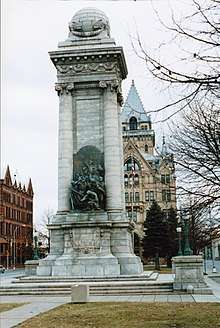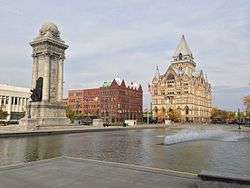Soldiers and Sailors Monument (Syracuse, New York)

Soldiers and Sailors Monument (1908-11) is a Beaux Arts monument in Syracuse, New York, dedicated to the 12,265 men of Onondaga County who served in the Civil War.[1] It was designed by architect Clarence Blackall, with bronze sculpture by Cyrus Dallin, and was erected in Clinton Square, alongside the Erie Canal.[2]
The monument consists of a square granite pylon with attached Roman Ionic columns at its corners, supporting a heavy cornice with a carved frieze, and crowned by a globe guarded by four eagles grasping a thick garland. This is set atop a plinth, and a stepped plaza with corner piers supporting bronze lampposts. The pylon's east and west sides are adorned with bronze high-relief sculpture groups (by Dallin). The north and south sides feature granite reliefs of flags and military accoutrements. The plith features dedication plaques, and a quotation from President Abraham Lincoln's Gettysburg Address.[1] The monument is approximately 75 ft (22.86 m) tall.[1]
Dallin won a design competition to produce the two monumental bronze groups, The Call to Arms and An Incident at Gettysburg.[3] The competition's judges included J. Q. A. Ward and Daniel Chester French.[4] The Incident at Gettysburg group depicts the moment when a Syracuse native, Color Sergeant William C. Lilly of the 149th New York Infantry, paused in the middle of a firefight to repair a broken flagstaff with his belt. Lilly survived Gettysburg but was killed in a later engagement in the War.[2]
The monument's cornerstone was laid on Memorial Day, May 31, 1909.[1] It was dedicated on June 21, 1910,[1] although only Dallin’s The Call to Arms had been installed.[1] Dallin's assistant, Frederick MacMonnies, had been sent to France to attend to the other sculpture group's casting in bronze, but instead got married and went off on his honeymoon.[2] The Incident at Gettysburg was dedicated on June 23, 1911.[1]
The Syracuse section of the Erie Canal was filled in and paved over in 1925, to create Erie Boulevard.[5] The monument's original granite plaza measured 50 ft (15.24 m) by 150 ft (45.72 m),[1] but the sections east and west of its central portion were removed in the 1930s, and replaced by landscaping.[5] A reflecting pool that traces the canal's former path was constructed alongside the monument in 2001.[5] It features fountain jets in warm weather and becomes an iceskating rink in winter.[5]
 Monument in a 1910 postcard.
Monument in a 1910 postcard.- The Call to Arms by Dallin.
- An Incident at Gettysburg by Dallin.
 Monument (with original plaza) and Erie Canal in a 1917 postcard.
Monument (with original plaza) and Erie Canal in a 1917 postcard. Monument and reflecting pool, 2013.
Monument and reflecting pool, 2013.
References
- 1 2 3 4 5 6 7 8 Soldiers and Sailors Monument, from SIRIS.
- 1 2 3 Hardin, Evamaria, Syracuse Landmarks: An AIA Guide to Downtown and Historic Neighborhoods, photographs by Jon Crispan, Syracuse University Press and Onondaga Historical Society, pp. 34-35.
- ↑ The Monumental News, vol. 20, no. 8 (August 1908).
- ↑ Ahrens, Kent, Cyrus E. Dallin: His Small Bronzes and Plasters, Rockwell Museum, Corning, NY, 1995, p. 74.
- 1 2 3 4 Layden, Sarah. "The Square comes full circle". The Post-Standard. Syracuse, New York September 2, 2001. Retrieved September 2, 2017.
Coordinates: 43°03′11″N 75°09′10″W / 43.053089°N 75.152899°W
| Wikimedia Commons has media related to Soldiers and Sailors Monument (Syracuse, New York). |